You're just a few steps away from creating a peaceful retreat in your own backyard with a DIY pond. By determining the purpose of your pond, you'll set the stage for a harmonious blend of design and functionality. But before you start digging, you'll need to ponder the ideal location, taking into account sunlight and slope. With these basics covered, you'll be ready to plunge into the fun part – selecting materials and building your pond. But what types of materials will you need, and how will you guarantee your pond's ecosystem flourishes?
Planning Your Backyard Pond
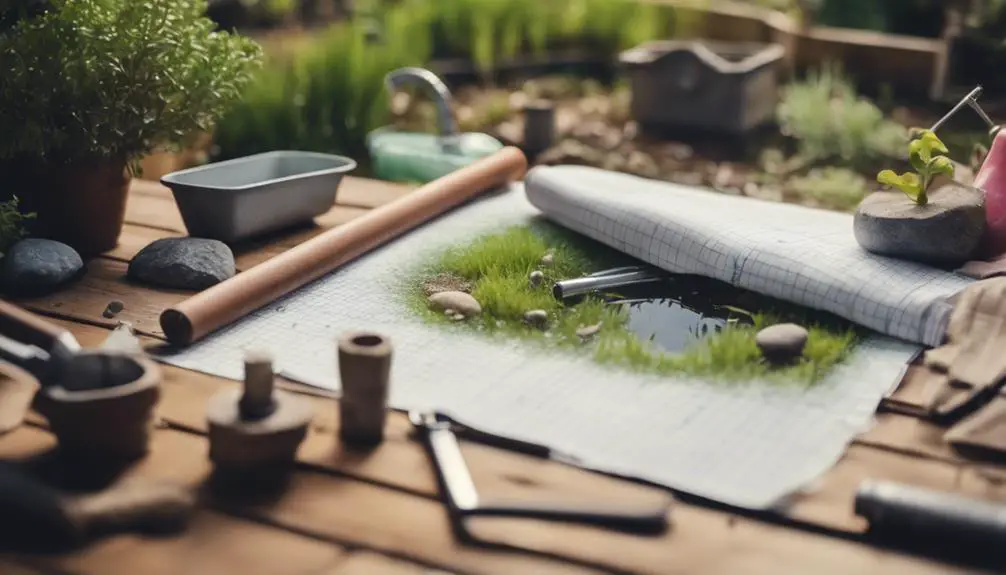
Determine the purpose of your backyard pond, whether it's to attract wildlife, create a serene atmosphere, or showcase aquatic plants, to guide your design and construction decisions.
As you plan your backyard pond, you'll need to weigh two vital factors: pond size and budget constraints.
The size of your pond will impact the overall aesthetic and functionality of your outdoor space. A larger pond will provide a more dramatic visual impact, but it will also require more materials and maintenance. On the other hand, a smaller pond can be a charming addition to your yard, but it may not provide the same level of tranquility.
Your budget will also play a significant role in determining the size and features of your pond. You'll need to balance your desires with the cost of materials, labor, and ongoing maintenance.
Choosing the Right Location
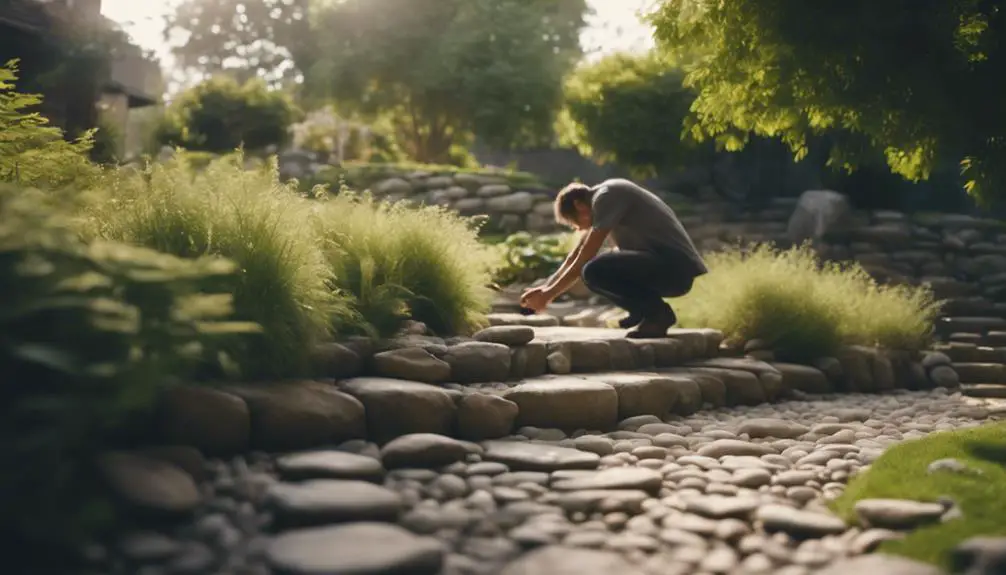
As you scout out the perfect spot for your backyard pond, consider the path of the sun, since a location that receives partial shade to full sun will promote healthy plant growth and prevent excessive algae buildup.
Observe the sunlight patterns in your yard throughout the day, taking note of areas that receive direct sunlight for at least six hours. This will guarantee your pond's ecosystem thrives.
Next, assess your yard's slope. A level or slightly sloping area is ideal, as it will prevent water from accumulating or flowing unevenly.
Avoid low-lying areas where water may collect, as this can lead to erosion and other issues. Take into account any nearby trees or shrubs, as their roots can interfere with your pond's liner or plumbing.
Consider the view from your patio, deck, or windows, too – you'll want to enjoy your pond from multiple angles.
Selecting the Right Materials
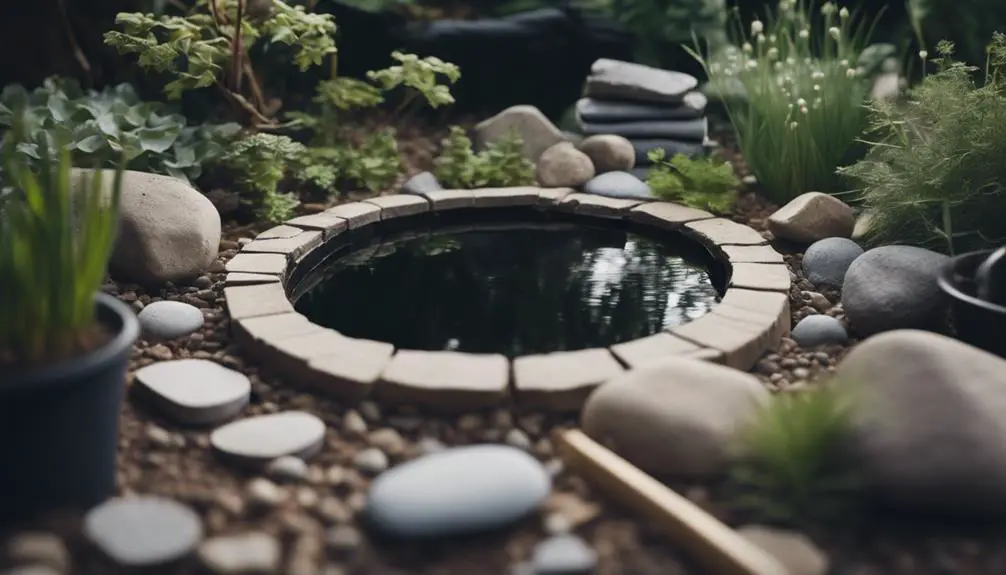
As you prepare to build your backyard pond, you'll need to select materials that can withstand the elements and support the ecosystem you're creating.
You'll want to ponder the type of pond liner that will best contain the water, the pump and filter systems that will keep it clean and clear, and the materials that will guarantee the structure's durability over time.
Pond Liner Options
When building a DIY backyard pond, you'll need to select a reliable pond liner that can withstand the elements and prevent leaks, which is why evaluating the right materials is crucial to ensuring the longevity of your water feature. A high-quality liner will prevent water loss, reduce maintenance, and keep your pond ecosystem healthy.
Liner thickness is a critical factor to ponder. A thicker liner provides added protection against punctures and tears, but may be more expensive. A minimum thickness of 30-40 mil is recommended for small to medium-sized ponds. For larger ponds, a thicker liner of 45-60 mil may be necessary.
In the event of a liner puncture, having a liner repair kit on hand can be a lifesaver. These kits usually include a special adhesive and patching material designed specifically for your liner type. By being prepared, you can quickly repair any damage and get your pond back to its former glory. With the right liner and repair kit, you can enjoy your backyard oasis for years to come.
Pump and Filter Types
You'll need to pair your reliable pond liner with a suitable pump and filter system to maintain ideal water circulation and quality, guaranteeing your pond's ecosystem remains healthy and thriving.
A submersible pump is a popular choice for small to medium-sized ponds, as it's energy-efficient and easy to install. However, for larger ponds, an external pump may be necessary to provide sufficient water flow.
When it comes to filters, you'll want to weigh the options for a combination of mechanical and biological filtration to remove debris and toxins from the water.
Regular Pump Maintenance is vital to prevent clogs and achieve peak performance. Consider investing in a pump with a built-in alarm system to alert you of any issues.
Additionally, Filter Upgrades can be made as your pond matures, allowing you to customize your system to meet specific water quality needs.
Material Durability Factors
Selecting materials that can withstand the elements and pond conditions is crucial, so consider the durability factors of liners, pumps, and other equipment to guarantee your DIY backyard pond remains a thriving oasis for years to come.
When choosing a liner, look for materials that have undergone rigorous material testing for puncture resistance, UV stability, and flexibility. A high-quality liner should be able to withstand extreme weather conditions, such as intense sunlight, heavy rainfall, and freezing temperatures.
For pumps and filters, consider their weather resistance and ability to function efficiently in varying water conditions. You'll want equipment that can handle the constant flow of water and resist corrosion.
Additionally, consider the durability of other components, such as tubing, fittings, and valves. These should be able to withstand water pressure and resist cracking or breaking.
Building the Pond Container
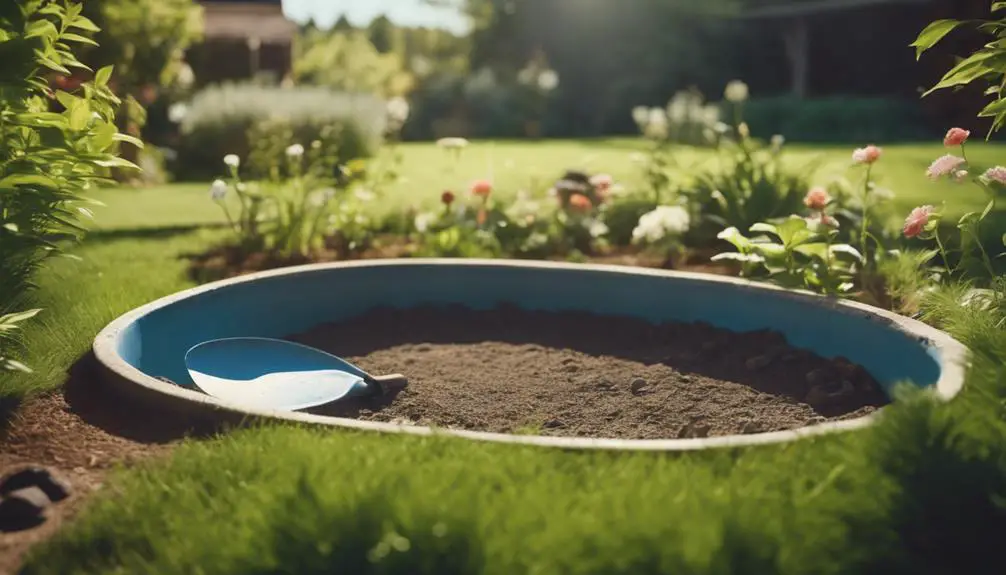
Measure the area where you plan to install your pond, taking precise notes on the length, width, and any obstacles that will affect the container's shape and size. Consider the pond depth, which typically ranges from 18 to 36 inches, depending on the type of plants and fish you plan to introduce. A deeper pond provides more stability and allows for a wider range of aquatic life.
When choosing a container shape, consider the aesthetics of your backyard and the functionality of the pond. Rectangular or square containers provide a modern look, while circular or oval shapes create a more natural ambiance. You can also opt for a pre-formed pond container, which comes in various shapes and sizes.
To build your pond container, you'll need to excavate the area, taking care to level the ground. Use a liner underlayment to protect the liner from punctures and guarantee a smooth installation. You can use concrete, stone, or wood to create the container, depending on your desired look and budget. Make sure to follow local building codes and regulations, and consult with a professional if you're unsure about any aspect of the process. With careful planning and execution, your DIY backyard pond will become a serene oasis.
Installing the Liner and Pump
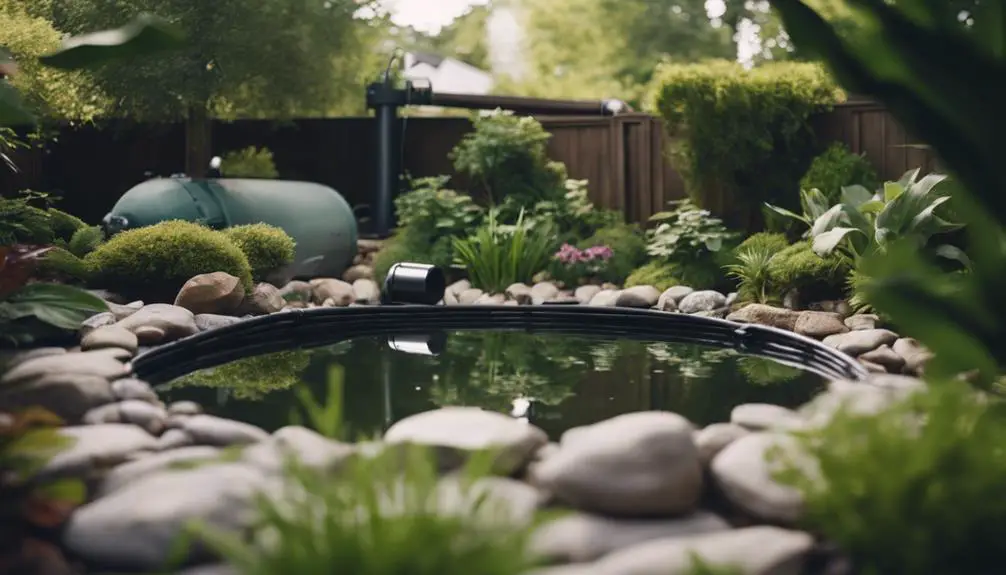
With the pond container excavated and prepared, the next crucial step is to carefully place the liner, guaranteeing a snug fit and precise positioning to prevent wrinkles, creases, or air pockets that could compromise the pond's integrity.
You'll want to unfold the liner and allow it to relax in the sun for a few hours to remove any folds or creases. Then, carefully place it in the pond container, starting from the center and working your way outward. Make sure to smooth out any wrinkles or air pockets as you go, using a soft brush or broom to remove any stubborn creases.
Once the liner is in place, you can install the pump. Choose a pump that's designed for ponds and follow the manufacturer's instructions for installation.
Make sure the pump is submerged in the water and securely fastened to the liner to prevent pond leaks. A well-installed liner and pump will guarantee your pond remains watertight and runs efficiently.
Remember to regularly inspect your liner for signs of wear or damage, and address any issues promptly to prevent liner wrinkles or pond leaks from developing.
Adding Water and Gravel
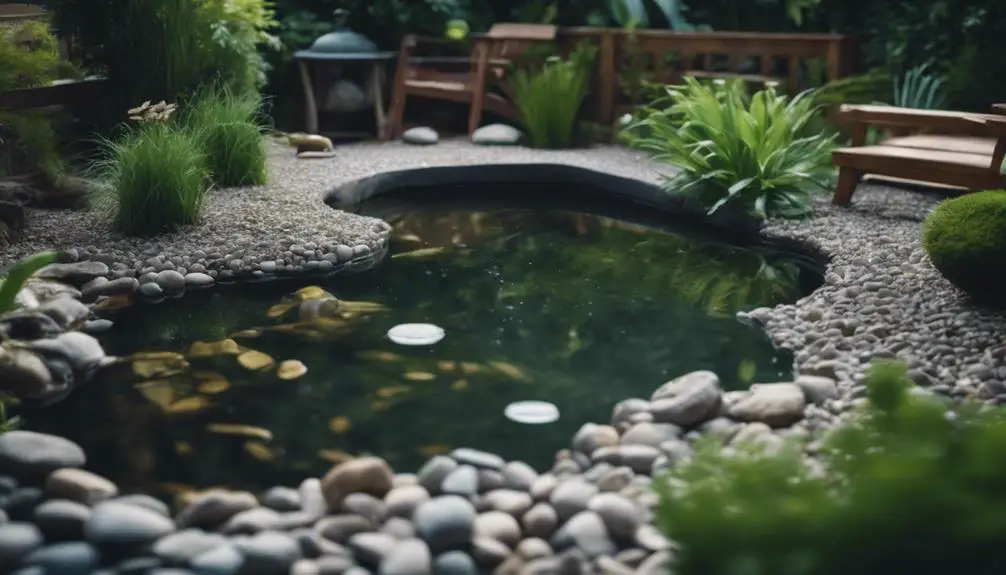
Now that your pond's liner and pump are in place, you're ready to add the water and gravel that'll bring your backyard oasis to life.
First, you'll need to check the water level to verify it's at the ideal height for your pump and surrounding landscape.
Next, you'll create a gravel base layer, followed by filling the pond with water to complete this vital step.
Water Level Check
You'll need to add water to the pond until it reaches about an inch below the top of the liner, verifying the water level is evenly distributed across the entire surface. This vital step requires attention to detail to achieve a balanced water table.
Take a walk around the pond, visually inspecting the water level against the liner's edge. Make sure it's consistent, with no areas lower or higher than others.
To confirm accuracy, create level markings on the liner using a marker or a piece of tape. This will help you monitor the water level and make adjustments as needed.
Check the water level against these markings regularly, adding or removing water to maintain the desired level. A consistent water level is essential for a healthy ecosystem and a visually appealing pond.
As you add water, observe how it interacts with the surrounding landscape, verifying it doesn't overflow or create puddles. By maintaining a balanced water table, you'll create a thriving environment for your aquatic plants and animals.
Gravel Base Layer
As you prepare to create a stable foundation for your pond's ecosystem, spreading a layer of gravel across the pond floor becomes a crucial step, allowing you to achieve a smooth, even surface for your liner and preventing punctures or damage.
A recommended gravel depth of 1-2 inches is ideal, providing sufficient coverage without overwhelming the pond's base.
When selecting gravel, consider a color that complements your pond's surroundings, such as a neutral beige or brown tone that blends seamlessly with natural rocks and plants. Avoid using bright or bold colors, as they may distract from the pond's overall aesthetic.
As you spread the gravel, guarantee it's evenly distributed, using a rake or trowel to smooth out any bumps or ridges.
Pay attention to areas around the pond's edges, where gravel may accumulate or wash away.
Filling the Pond
With the gravel base layer evenly distributed, fill the pond by slowly adding water to prevent washaway, while simultaneously adding more gravel around the edges to maintain a consistent depth. This careful approach guarantees the pond's structural integrity and prevents erosion.
As you fill, monitor the water volume to achieve the desired level. You can calculate the water volume by measuring the pond's length, width, and depth.
You have two filling options: using a hose or a water delivery service. If using a hose, position it at the pond's edge to minimize disturbance to the gravel.
If you opt for a water delivery service, verify they use a hose or pipe to fill the pond slowly and carefully. As the pond fills, continue adding gravel around the edges to maintain a consistent depth. This will also help hide the pond's liner and create a natural-looking environment.
Throughout the filling process, inspect the pond's edges for any signs of washaway or erosion, making adjustments as needed. By filling your pond slowly and carefully, you'll create a beautiful, thriving ecosystem that will bring joy to your backyard.
Creating a Natural Ecosystem
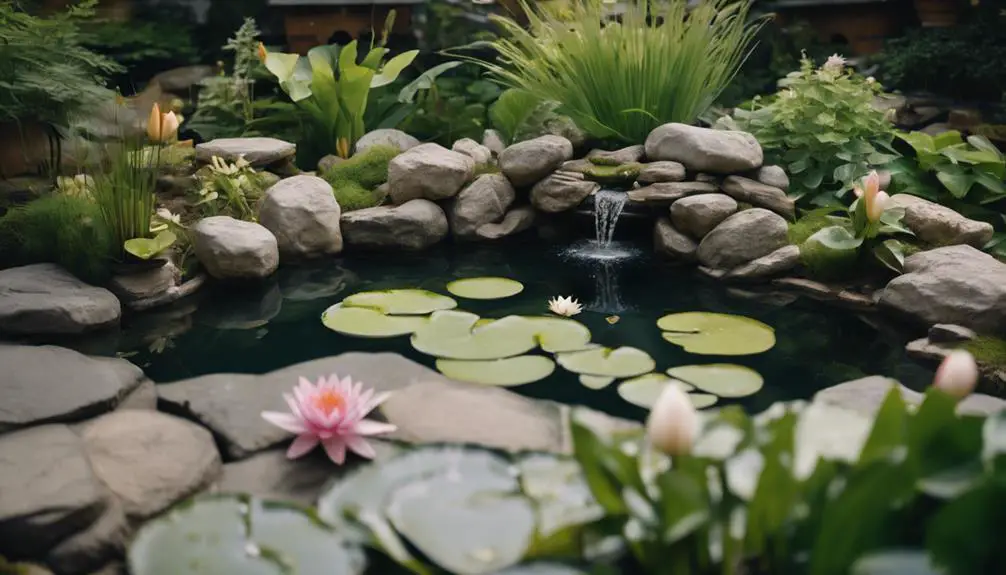
Your backyard pond's ecosystem comes alive when beneficial bacteria, aquatic plants, and microscopic organisms work in harmony to break down decaying matter and recycle nutrients.
This delicate balance is vital for maintaining ecosystem balance, ensuring a thriving aquatic habitat. As you introduce these elements, you'll notice a significant reduction in algae growth and a decrease in pond maintenance.
To create this harmonious environment, you'll need to introduce beneficial bacteria to your pond.
These microorganisms will break down organic matter, converting it into nutrients for your aquatic plants. This process not only keeps your pond clean but also provides a natural food source for your plants.
As your ecosystem matures, you'll observe a decrease in water cloudiness and an increase in water clarity. This, in turn, will promote a healthy aquatic habitat, perfect for supporting aquatic life.
Introducing Aquatic Plants

As you design your backyard pond, you'll want to carefully select aquatic plants that thrive in your specific water conditions and climate.
You'll need to ponder factors like light requirements, water depth, and nutrient levels to guarantee your chosen plants flourish.
Types of Plants
Create a thriving ecosystem in your DIY backyard pond by introducing aquatic plants, which not only add visual appeal but also provide essential benefits like water filtration and habitat creation.
You'll be surprised at the variety of plants you can choose from to create a unique and thriving environment.
For a touch of elegance, consider adding Water Lilies to your pond. These beautiful plants come in a range of colors and sizes, and their large leaves provide shade and shelter for fish and other aquatic creatures. Plus, they help to keep the water clean by absorbing excess nutrients.
If you're looking for a more natural, unstructured look, Bog Gardens might be the way to go. These plants thrive in shallow water and can tolerate a range of conditions, making them perfect for ponds with varying water levels.
Bog Gardens also provide a habitat for beneficial insects and microorganisms, which help to break down organic matter and keep your pond healthy. By incorporating these plants into your DIY backyard pond, you'll create a thriving ecosystem that's both beautiful and functional.
Plant Care Essentials
Before introducing aquatic plants to your DIY backyard pond, assess the water's pH levels, temperature, and lighting conditions to guarantee ideal growth and health.
You'll want to verify your pond's water chemistry is balanced, with a pH between 6.5 and 8.5, and temperatures ranging from 65°F to 85°F (18°C to 30°C).
Adequate lighting is also vital, with most aquatic plants requiring 4-6 hours of direct sunlight or 10-12 hours of indirect sunlight.
Once you've optimized your pond's environment, focus on providing your plants with essential nutrients.
Plant Nutrition is critical for healthy growth and development.
You can use aquatic plant fertilizers, which contain essential micronutrients like iron, manganese, and copper.
Regularly monitor your plants' health, watching for signs of nutrient deficiency or Aquatic Health issues.
Prune or divide overgrown plants to maintain a balanced ecosystem.
Adding Decorative Elements
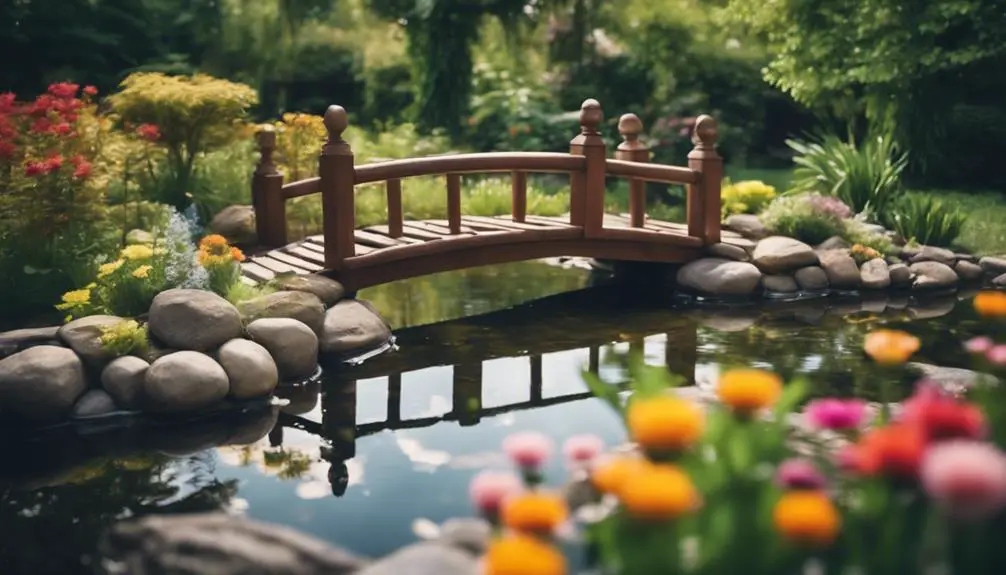
You'll now focus on incorporating visually appealing decorative elements, such as water features, statues, or plants, to transform your backyard pond into a serene oasis.
These elements not only add aesthetic value but also create a sense of tranquility and relaxation.
To start, consider Pond Lighting, which can be used to highlight specific features, create ambiance, or simply provide safety after dark.
Solar-powered lights are a great option, as they're energy-efficient and easy to install.
When selecting Water Features, think about the overall theme and style of your pond.
For example, a small fountain can add a touch of elegance, while a larger waterfall can create a dramatic effect.
Be sure to choose features that are proportional to your pond's size and style.
Additionally, statues, bird baths, or other ornaments can add visual interest and create a sense of whimsy.
Finally, don't forget to incorporate plants around the pond's perimeter to create a natural, harmonious look.
Installing a Water Feature
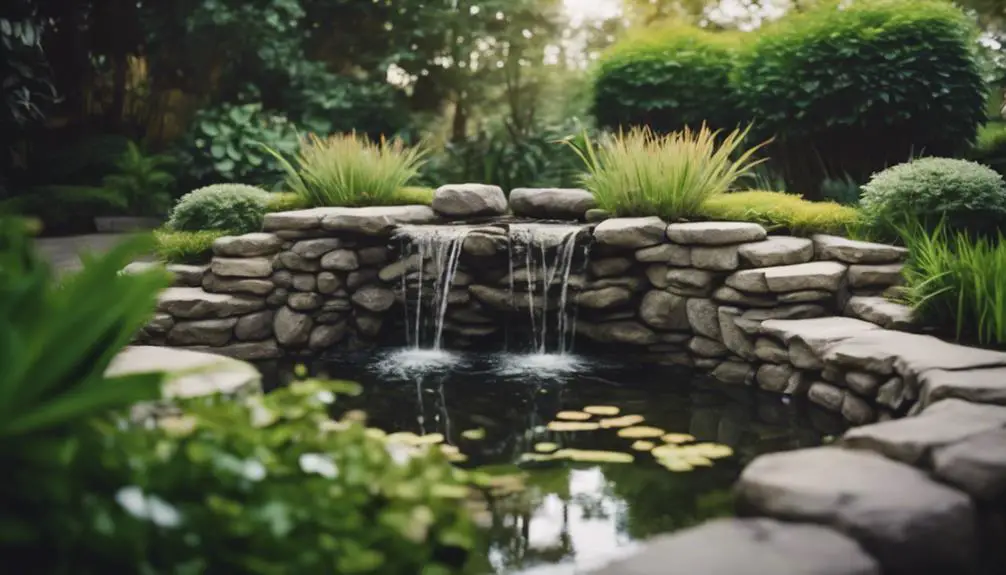
With your pond's aesthetic framework established, it's time to bring it to life with the soothing sounds and visual appeal of a water feature, which can be installed at the pond's edge or even within the water itself.
You can choose from a variety of options, including a small fountain, a bubbler, or a spitter.
When selecting a water feature, consider the overall style of your pond and the sound you want to create.
For a more subtle effect, a small fountain or bubbler can create a gentle water sound that adds to the pond's ambiance.
If you want to make a statement, a larger fountain or spitter can create a dramatic visual appeal.
When installing your water feature, make sure to follow the manufacturer's instructions and take necessary safety precautions.
You'll need to guarantee that the feature is properly secured and level, and that the water flow is adjusted to your liking.
With the right installation, your water feature will become the focal point of your backyard pond, creating a sense of serenity and visual interest.
Maintaining Water Quality
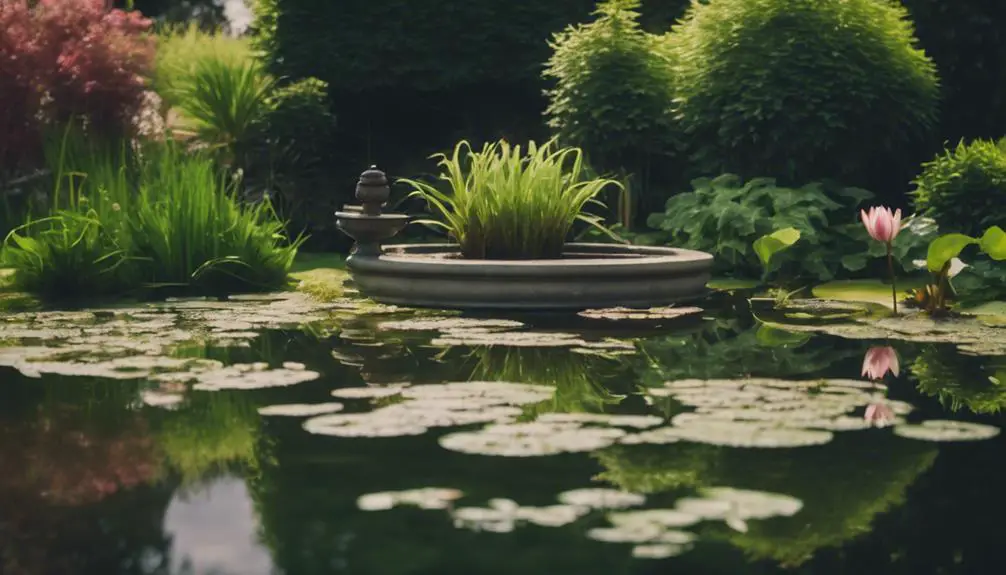
Your pond's ecosystem relies on maintaining prime water quality, which involves regular monitoring and management of parameters like pH, ammonia, and nitrite levels to guarantee a healthy environment for aquatic life.
To achieve this, you'll need to perform regular water testing to identify any imbalances. Invest in a water test kit that measures pH, ammonia, nitrite, and nitrate levels. Take water samples from different areas of the pond, including the surface and bottom, to get an accurate reading.
Based on your test results, you may need to perform chemical balancing to adjust the pH levels or remove excess ammonia and nitrite. You can use pH adjusters, ammonia removers, or beneficial bacteria supplements to restore balance to your pond's ecosystem.
Remember to always follow the manufacturer's instructions when adding any chemicals to your pond. By regularly testing and balancing your water, you'll create a thriving environment for your aquatic plants and animals. With a little effort, you can enjoy a vibrant and healthy pond that's a haven for wildlife and a soothing oasis for you.
Controlling Algae Growth
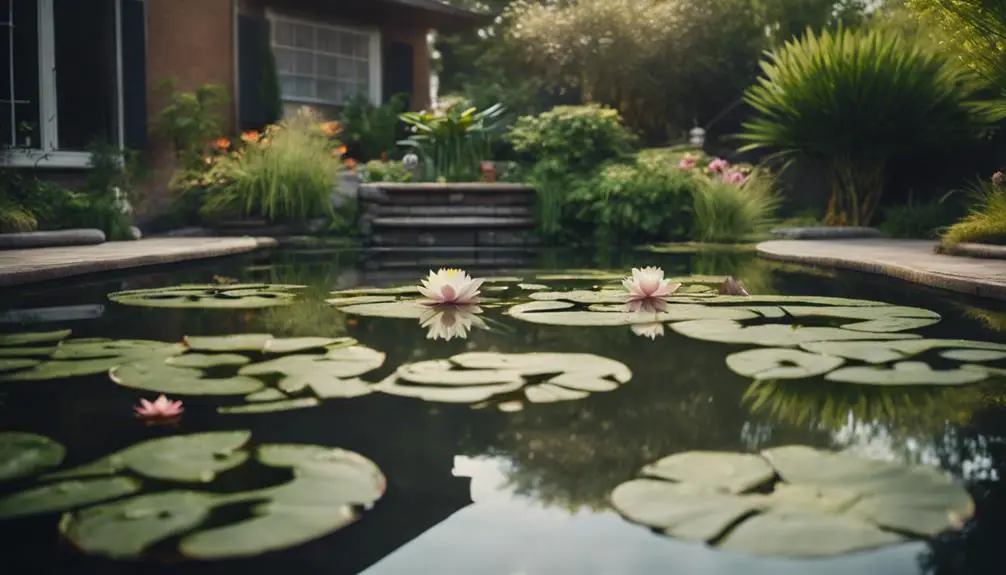
As you've worked to maintain ideal water quality, you're likely aware that excessive algae growth can quickly undermine those efforts, so it's time to implement strategies for keeping this nuisance under control.
One effective algae prevention method is to introduce beneficial bacteria into your pond's ecosystem. These microorganisms break down organic matter, preventing it from fueling algae growth.
You can add bacteria supplements or create a natural balance by incorporating plants that absorb excess nutrients, such as water lilies or cattails.
Regular water changes and skimming the surface for debris can also help reduce algae-promoting substances.
Additionally, consider installing a UV clarifier, which emits UV light that inhibits algae growth.
By implementing these methods, you'll maintain a natural balance and prevent algae from taking over your pond.
Remember, prevention is key, so monitor your pond's conditions regularly to catch any potential issues before they escalate.
With these strategies in place, you'll enjoy a thriving, algae-free backyard oasis.
Winterizing Your Pond
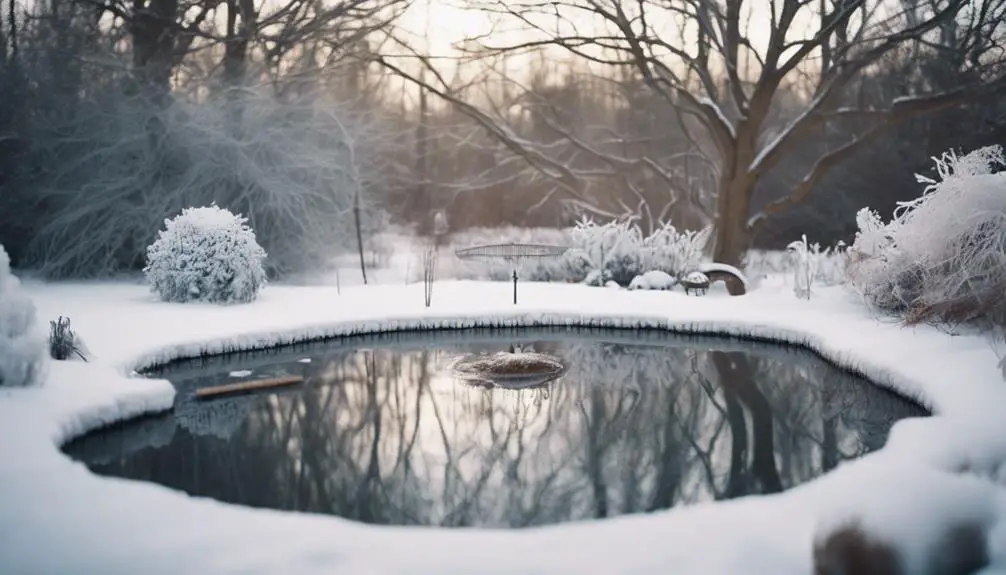
To guarantee your pond remains healthy and intact during the harsh winter months, you'll need to take proactive steps to prepare it for freezing temperatures and reduced sunlight.
Start by removing any floating plants or debris that could decay and contaminate the water. Next, clean your pond's filter and skimmer to certify they're functioning efficiently. You'll also want to add a winterizing kit to your pond, which typically includes a beneficial bacteria supplement and an algaecide to combat any algae growth.
As part of your Pond Preparation, consider adding a pond aerator to increase oxygen levels and reduce stagnation. This will help keep your pond's ecosystem balanced and healthy.
Don't forget about Winter Aesthetics – add some winter-hardy plants like ornamental grasses or evergreen shrubs around your pond to maintain visual interest.
Frequently Asked Questions
Can I Have a Backyard Pond With a Small Yard?
You can still enjoy a backyard pond, even with space constraints, by incorporating clever yard design elements, like vertical installations or compact shapes, to maximize visual impact in a small area.
How Do I Prevent Raccoons From Raiding My Pond?
To safeguard your serene oasis, you'll want to deploy raccoon deterrents like motion-activated sprinklers and ammonia-soaked rags. Consider installing pond fencing, such as a 3-foot tall, raccoon-proof mesh enclosure, to keep these masked bandits at bay.
Are Backyard Ponds Safe for Pets and Children?
When you install a pond, you'll want to guarantee it's safe for pets and kids; you'll need pet supervision and maintain good water clarity to prevent accidents, making it a serene oasis for everyone to enjoy.
Can I Add Fish to My Pond in the Winter?
When adding fish to your pond in winter, you'll need to prioritize winter fish care, as they'll require a stable environment to hibernate; guarantee adequate oxygen, proper water quality, and a balanced ecosystem to support their dormancy.
Do Backyard Ponds Attract Mosquitoes and Other Pests?
When creating a water feature, you'll want to ponder pest control methods, as still water can attract mosquitoes and other pests. Installing water circulation systems can help prevent this, keeping your water flowing and pest-free.
Conclusion
You've successfully created a serene backyard oasis with your DIY pond.
Sit back and enjoy the soothing sounds of water and the vibrant colors of aquatic plants and fish.
Regular maintenance will guarantee a thriving ecosystem. Monitor water quality, control algae growth, and winterize your pond to keep it looking its best.
With proper care, your backyard pond will become a haven for relaxation and entertainment, providing years of enjoyment for you and your loved ones.




